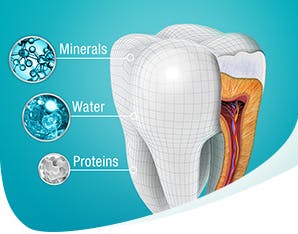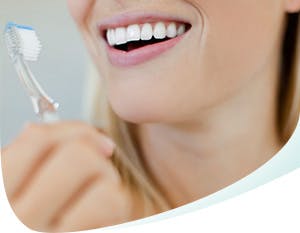How to Stop Tooth Decay and Prevent Cavities
We put our teeth through a lot on a daily basis, which is why it’s important to take good care of them. The way we maintain our oral health and the foods we eat can impact the condition of our teeth. As strong as teeth are, oral health conditions such as cavities can easily harm them and lead to more serious problems.
What is tooth decay and how can it be stopped? Continue reading to learn more about tooth decay and how it can be prevented.
What Is Tooth Decay?
There are four types of dental tissue that make up your teeth.1 Among these four types are enamel, which is the hard, outermost layer of the tooth.1 Tooth decay occurs when the enamel is damaged.2 If left untreated, tooth decay can damage the pulp of the tooth and in severe cases, where damage to the pulp cannot be fixed, will require a tooth extraction.2
How Does Tooth Decay Happen?
Although enamel is very strong, it does not contain living cells that can repair itself.1 Enamel is made up of minerals, and our teeth naturally go through the process of losing and regaining minerals all day.2 The minerals in enamel wear away when harmful bacteria in our mouths combine with food particles to form a sticky substance called plaque.2 The bacteria in plaque use the sugars that are found in the foods you eat to create an acid that attacks your enamel.2 The continued loss of minerals in the enamel will eventually lead to tooth decay.
Eating too many sugary or starchy foods and drinks and not taking care of your teeth by brushing twice a day with fluoride toothpaste are some of the main reasons why tooth decay can happen.2 People who don't produce enough saliva due to side effects from medications or certain diseases are more likely to experience tooth decay.2 Saliva is important for rebuilding the enamel, and without it you are at a higher risk for tooth decay.2
What Are the Symptoms of Tooth Decay?
You may experience many symptoms during the early stages of tooth decay.2 One common symptom of early tooth decay is the appearance of white spots on the surface of your teeth to indicate where minerals have been lost.2 At this point, tooth decay is still reversible and your enamel can still be repaired.2 However, as tooth decay gets worse, you may start to experience toothaches, tooth sensitivity, white or brown surface stains, cavities (holes in your teeth), and infections that can lead to abscesses.2 Decay around the edges of dental fillings is also a common symptom in older adults.3
What Are Cavities?
Cavities, or dental caries, are holes that appear in your teeth as a result of tooth decay. A cavity indicates permanent damage to the tooth, and only a dentist can repair them when they form.2 Cavities are quite common among both children and adults.3 Approximately 91% of adults over 20 years old in America have had at least one cavity.4
How to Prevent Tooth Decay and Cavities
Getting regular dental checkups is the best way to both treat and prevent tooth decay. Your dentist and dental hygienist can professionally clean your teeth and perform an oral examination to catch any signs of tooth decay or cavities.3 Talk to your dentist about preventive dental sealants, a protective coating that is applied to the chewing surfaces of back teeth.3 Tooth decay often starts in the back teeth, and dental sealants can protect them from decay.3
While visiting the dentist is important, you can also take your own measures to help prevent tooth decay and cavities. If you are consuming too many sugary foods and drinks, making a few changes to your diet may help in the long run. Eating nutritious and balanced meals while keeping snacking to a minimum can help minimize the risk of tooth decay.3 Make sure to clean between your teeth with floss or an interdental cleaner, and brush your teeth properly with a fluoride toothpaste.3
What Is Fluoride?
The best way to strengthen your enamel on your own is by using fluoride on your teeth. Fluoride, which can be found in toothpastes and tap water, helps to repair the enamel by replacing the minerals that are lost.2 It helps prevent cavities by making the enamel more resistant to acid attacks that cause tooth decay.5 Fluoride also helps to remineralize tooth enamel and reverse early signs of tooth decay.5 You can get fluoride through certain foods, tap water from fluoridated community water systems, and from brushing with a fluoride toothpaste.5 Try products such as Pronamel Daily Protection Toothpaste and Pronamel Intensive Enamel Repair Clean Mint Toothpaste to help repair acid-weakened teeth and protect your teeth every day. You can also try Pronamel’s new toothpaste, Pronamel Active Shield, which actively reinforces weakened tooth enamel and shields against cavities. Pronamel Active Shield enamel toothpaste works by driving fluoride minerals deep into the tooth’s surface, creating a remineralized and strengthened layer that’s more resistant to future acid attacks to help keep enamel in its prime.
While cavities can be a pain to deal with, they can be prevented through good oral hygiene habits. Find more enamel health tips on the Pronamel website.
Source Citations:
- Tooth. American Dental Association. https://www.mouthhealthy.org/en/az-topics/t/tooth Accessed 8/19/2022.
- Tooth Decay. MedlinePlus. https://medlineplus.gov/toothdecay.html Accessed 8/19/2022.
- Tooth Decay. American Dental Association. https://www.mouthhealthy.org/en/az-topics/d/decay Accessed 8/19/2022.
- 6 Ways to Prevent Adult Cavities. American Dental Association. https://www.mouthhealthy.org/all-topics-a-z/tooth-decay Accessed 8/22/2022.
- Fluoride. American Dental Association. https://www.mouthhealthy.org/en/az-topics/f/fluoride Accessed 8/22/2022.




